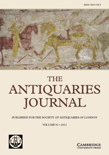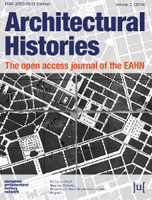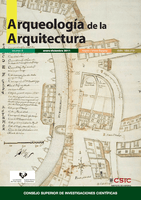
Journal of Historic Buildings and Places
Scope & Guideline
Empowering Preservationists with Open Access Insights.
Introduction
Aims and Scopes
- Architectural History and Heritage Studies:
The journal emphasizes the historical analysis of architecture and urbanism, showcasing research that investigates the evolution of building styles, materials, and techniques over time. - Cultural and Social Contexts of Architecture:
It explores the relationship between architecture and its cultural, social, and political contexts, examining how buildings reflect and influence societal values and historical events. - Preservation and Conservation Practices:
The journal addresses contemporary challenges in the preservation and conservation of historic buildings, promoting discussions on best practices and innovative approaches to maintaining architectural heritage. - Interdisciplinary Approaches:
It encourages interdisciplinary research, integrating perspectives from history, sociology, art history, and urban studies to provide a comprehensive understanding of historic buildings and places. - Regional Studies and Case Studies:
The journal features in-depth case studies that highlight specific regions and notable buildings, providing localized insights into architectural heritage.
Trending and Emerging
- Post-Colonial Architecture:
The journal has seen an increase in studies examining post-colonial architecture, particularly in urban environments shaped by colonial histories, emphasizing the complexities of identity and heritage in former colonies. - Modern and Brutalist Architecture:
Research focusing on modern and Brutalist architecture has gained traction, reflecting a growing interest in the significance of 20th-century architectural movements and their cultural implications. - Sustainability and Adaptive Reuse:
There is a rising trend in discussions surrounding sustainable practices in architecture, particularly adaptive reuse of historic buildings, addressing both environmental concerns and heritage preservation. - Digital Humanities in Architecture:
Emerging methodologies utilizing digital humanities tools and techniques are becoming prominent, allowing for innovative ways to analyze and visualize architectural history and heritage. - Community Engagement and Participatory Design:
The journal is increasingly featuring themes that explore community involvement in heritage conservation and participatory design processes, emphasizing the role of local communities in shaping their built environment.
Declining or Waning
- Traditional Architectural Styles:
There has been a noticeable decline in papers focusing exclusively on traditional architectural styles, such as Victorian or Edwardian architecture, as the field increasingly embraces modernist and contemporary interpretations. - Static Historical Narratives:
Research that presents static narratives of architectural history without considering dynamic socio-political contexts is waning, as scholars seek more nuanced and multifaceted analyses. - Single-Building Studies:
The focus on individual buildings as isolated entities is decreasing, with a trend towards broader thematic studies that connect multiple buildings or urban developments within a historical framework. - Local vs. Global Perspectives:
There seems to be a diminishing emphasis on purely local studies without global context, as researchers are increasingly recognizing the importance of global architectural influences and transnational dialogues.
Similar Journals

Architektura & Urbanizmus
Pioneering Research for Sustainable Urban FuturesArchitektura & Urbanizmus is a distinguished scholarly journal published by the Institute of History at the Slovak Academy of Sciences, with a specific focus on the fields of architecture, conservation, and urban studies. Since its transition to Open Access in 2021, the journal aims to broaden the accessibility of vital research findings to a global audience, fostering knowledge-sharing and collaboration among scholars, practitioners, and students alike. The journal has consistently contributed to the academic discourse since its inception and now spans converged years from 2007 to 2023, adapting to the evolving landscape of its disciplines. With its categorization in Q3 for both Architecture and Conservation, and Q4 in Urban Studies for 2023, it stands as a credible platform for disseminating innovative research and practical insights. The journal's current Scopus rankings reflect its growing influence in the field, offering a significant opportunity for researchers to contribute original work that addresses contemporary challenges in architecture and urban development. Situated in the heart of Bratislava, Slovakia, at Klemensova 19, Architektura & Urbanizmus invites contributions that enrich the architectural heritage and environmental integrity of urban spaces.

Art-Sanat
Exploring the Rich Tapestry of Art and CultureArt-Sanat is a distinguished open-access journal published by the Research Institute of Turkology at Istanbul University, focusing on various facets of art history, visual arts, and cultural heritage. Since its open-access launch in 2017, the journal has been dedicated to promoting scholarly communication and disseminating innovative research within the fields of Art History, Archaeology, and Conservation. With an impact factor that highlights its increasing prominence—ranking in the Q1 quartile for History and Visual Arts and Performing Arts—Art-Sanat provides a platform for researchers, professionals, and students to share high-quality studies. The journal's commitment to transparency and accessibility assures that its contributions are available to a global audience, fostering a community of inquiry in the rich and diverse artistic landscapes of Turkey and beyond. With a robust ranking in Scopus, it stands as a noteworthy resource that advances scholarly engagement and interdisciplinary dialogue in the arts and humanities.

Disegnare Idee Immagini-Ideas Images
Unveiling the Artistry Behind Architectural InnovationDisegnare Idee Immagini-Ideas Images is a distinguished academic journal published by GANGEMI EDITORE SPA, specializing in the fields of Architecture, Visual Arts, and Performing Arts. With an ISSN of 1123-9247, this journal serves as a vital platform for the dissemination of innovative ideas and research findings in these dynamic disciplines. Over its publication span from 2009 to 2023, it has established itself in the academic community, achieving a respectable ranking in the third quartile for Architecture and second quartile for Visual Arts and Performing Arts as of 2023. Although not an Open Access journal, it offers rich content that appeals to researchers, professionals, and students alike, fostering collaboration and dialogue among scholars in Italy and beyond. The journal is an invaluable resource for those looking to explore the intersections of design and artistic expression.

Antiquaries Journal
Navigating the Intersection of History and Visual Arts.The Antiquaries Journal, published by Cambridge University Press, is a prestigious publication dedicated to the multidisciplinary exploration of antiquarian studies, archaeology, history, and the visual arts. With an impact factor reflective of its influence within the academic community, it is essential reading for researchers, professionals, and students alike. This journal serves as a vital platform for disseminating cutting-edge research and scholarly discourse, particularly in its recent categorization within Q1 in Visual Arts and Performing Arts and Q2 in History. The journal spans a rich historical timeline from 1921 to the present, offering unique insights and fostering dialogue in the interrelated fields of archaeology and historical inquiry. While it is not an open-access journal, its commitment to rigorous peer review and academic excellence ensures that the content remains a critical resource for anyone engaged in the study of the past, particularly within the United Kingdom and beyond.

Architectural Histories
Innovative Insights into Architectural HeritageArchitectural Histories is a leading open-access journal published by UBIQUITY PRESS LTD since 2013, dedicated to the exploration and critique of architectural history. With an ISSN of 2050-5833 and an esteemed presence in the United Kingdom, the journal has gained notable recognition in various disciplines, achieving a Q2 ranking in Architecture, a Q1 ranking in History, and a Q1 ranking in Visual Arts and Performing Arts for 2023. It stands out with impressive Scopus ranks, placing it within the 79th percentile for Visual Arts and Performing Arts. The journal's scope emphasizes interdisciplinary approaches to architectural history, engaging researchers, professionals, and students alike in critical discourse. By providing a platform for innovative research and scholarly dialogue, Architectural Histories significantly contributes to the understanding of architecture's past and its implications for present and future practices, marking its importance in the academic community.

Constelaciones
Connecting scholars to illuminate contemporary issues.Constelaciones is a respected journal published by the FUNDACION UNIV SAN PABLO CEU, which serves as a vital platform for scholars and practitioners in the dynamic fields of cultural studies, social sciences, and humanities. With its ISSN 2340-177X and E-ISSN 2531-1360, this journal facilitates open dialogues on contemporary issues, featuring rigorous academic articles that contribute to theoretical frameworks and practical applications. The journal aims to foster interdisciplinary research and collaboration, making it an essential resource for researchers, professionals, and students. While detailed metrics such as impact factor and HIndex are yet to be established, the rich content and diverse scope signal the journal's commitment to advancing knowledge and enriching the academic community. Located in Alcorcón, Madrid, Spain, Constelaciones welcomes submissions that align with its mission of exploring innovative perspectives and emergent trends within its designated fields.

PRESERVATION
Reviving Conversations on Historic IntegrityPRESERVATION is a distinguished journal published by the NATL TRUST HISTORIC PRESERVATION, focusing on critical issues in historic preservation and conservation within the realm of arts and humanities. With an ISSN of 1090-9931, this journal served as a notable platform for research and discourse from 2002 to 2018, although its coverage was discontinued in Scopus, where it held ranks that reflected its niche but valuable contributions to both visual arts and conservation. Despite its cessation, the journal remains a key resource for professionals and academics dedicated to preserving cultural heritage and advancing the study of preservation practices. The importance of PRESERVATION lies in its commitment to fostering an understanding of the challenges in maintaining historical integrity amidst modern developments. Researchers, practitioners, and students alike will find a wealth of knowledge and inspiration through its past issues, making it an essential reference point for those engaged in the ongoing dialogue around preservation methodologies and impacts.

Loggia Arquitectura & Restauracion
Navigating Contemporary Challenges in Architecture and the ArtsLoggia Arquitectura & Restauracion is a pivotal academic journal dedicated to the fields of architecture, conservation, and the visual arts, published by UNIV POLITECNICA VALENCIA, EDITORIAL UPV in Spain. With an ISSN of 1136-758X and an E-ISSN of 2444-1619, this Open Access journal has been providing a platform for scholarly discussions since 1996, enhancing the global dialogue on architectural methods and restoration practices. Boasting a Q3 ranking in both Architecture and Conservation, along with a Q2 ranking in Visual Arts and Performing Arts, the journal reflects a commitment to academic rigor and innovation, as it navigates the convergence of these important fields from 2019 to 2024. The research published in Loggia addresses critical contemporary issues, enriching the knowledge base for academics, practitioners, and students alike. With a current Scopus rank that situates it within the competitive landscape of arts and humanities, Loggia serves as a vital resource for those seeking to explore the intersection of culture, history, and sustainability in architectural practice.

TRANSACTIONS OF THE ANCIENT MONUMENTS SOCIETY
Fostering Dialogue on Heritage and ConservationTRANSACTIONS OF THE ANCIENT MONUMENTS SOCIETY is a distinguished journal published by the Ancient Monuments Society in the United Kingdom, focusing on the rich interplay between architecture, conservation, and religious studies as they pertain to ancient monuments and heritage. With an ISSN of 0951-001X, this journal serves as an essential platform for researchers, professionals, and students interested in exploring methodologies, case studies, and theoretical perspectives that enhance our understanding of historical preservation and cultural significance. Although it has been classified in Q4 quartiles in prominent categories such as Architecture, Conservation, and Religious Studies, the journal plays a vital role in fostering scholarly dialogue in these areas. Access options and updates are available, making it easier for enthusiasts and experts alike to engage with ongoing discussions surrounding ancient monuments. Despite its discontinued coverage in Scopus, the journal remains an invaluable resource for those aiming to contribute to the conservation discourse and to understand the relevance of ancient sites in contemporary society.

Arqueologia de la Arquitectura
Bridging Disciplines for a Deeper Understanding of Built HeritageArqueologia de la Arquitectura is a premier scholarly journal published by CONSEJO SUPERIOR INVESTIGACIONES CIENTIFICAS-CSIC, specializing in the intricate intersections of architecture, archaeology, and conservation. Since its inception in 2002, this Open Access journal has provided researchers, professionals, and students with a platform to share innovative findings that deepen our understanding of architectural heritage and its archaeological contexts. Based in Spain, it has demonstrated remarkable academic rigor and impact, achieving Q1 rankings in multiple categories, including Architecture and Visual Arts and Performing Arts, alongside a Q2 in Archaeology as of 2023. With a robust presence in Scopus, ranking within the 88th percentile for Visual Arts and Performing Arts, Arqueologia de la Arquitectura stands as a crucial resource for those dedicated to the preservation and study of our built heritage, encouraging interdisciplinary dialogue and research advancements in these elegant fields of study.